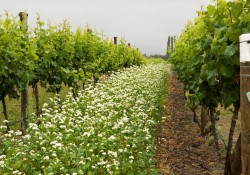
Sowing a cover crop is a wonderful way to work with nature on various issues in the vineyard.
Cover crops can be used for weed control, erosion control, building healthy and fertile soils, attracting beneficial insects etc. By choosing the right type or combination of cover crop various boxes can be ticked at the same time.
The idea of sowing Buckwheat to attract beneficial insects into the vineyard is fabulous and plenty of people have done so in the past successfully. Buckwheat is usually planted after the last frost. It thrives in cooler seasons and will establish quickly (starting to flower usually 6 weeks after sowing) smothering warm season annual weeds. It`s also believed that Buckwheat has an allelopathic weed suppressing effect, which is very useful to know. Furthermore, Buckwheat has a dense fibrous root system allowing the plant to scavenger nutrients in particular P and other minor nutrients which aren`t available to other plants until buckwheat residue breaks down. While growing, its roots produce mild acids that release the nutrients from the soil. The acids also activate slow releasing fertilisers such as RPR.
During recent year`s Buckwheat has worked brilliantly in most vineyards here in Marlborough. The heat and dry weather have kept the buckwheat short with plenty of flowers on offer. All benefits could be seen. This year we were experiencing a cold spring and summer, which has allowed the buckwheat to grow into large plants causing issues with powdery mildew in the rows for the first time in a local vineyard who has been using it before for many years.
What can we all learn from this season to help manage the Buckwheat in the interrow better in years to come?
- What worked last year doesn`t necessarily work next season, so keep monitoring and check weather predictions for your area.
- Be prepared to adjust your management. Is the prediction looking likely to be on the cold side again? Either delay planting time or manage Buckwheat differently. Buckwheat can be mowed and will regrow if cut before it reaches 25% bloom. Check height of the last growing points, you don`t want to cut below. Because Buckwheat is so quick to establish it could also be rolled at beginning of flowering, if timing is correct the plant will keep growing and flowering closer to the soil surface. You could also oversow at this time extending the total flowering period.
- The sowing rate should be dense enough to outcompete other weeds, if this is the main reason you are using the plant in the interrow for. At the same time, it should be light enough to allow air and sun to get to each plant. That way each individual can stretch and grow into a healthy plant, vine included.
- Planting Buckwheat in a mix with other plant species, which are also attracting to beneficial insects such as lacewings, ladybirds etc rather than another monoculture sward is an option.
Tall species could be mowed if needed to increase the airflow between the rows with small species still flowering and providing food and habitat.
Increasing biodiversity in the vineyard by introducing plant communities has many benefits, agroforestry principles can be used here.
I trust there are plenty of cover crops going into the soil again this autumn/ winter. Healthy soils are needed to grow healthy produce, vine included. We have been working against mother nature for many years. It takes time to overcome an addiction and to grow healthy soils and environments the mother nature way. I would like to encourage you to keep cover cropping and increase biodiversity, above and in the soil. It will take time to see the benefit`s but they will show one day.
Regards Maren
